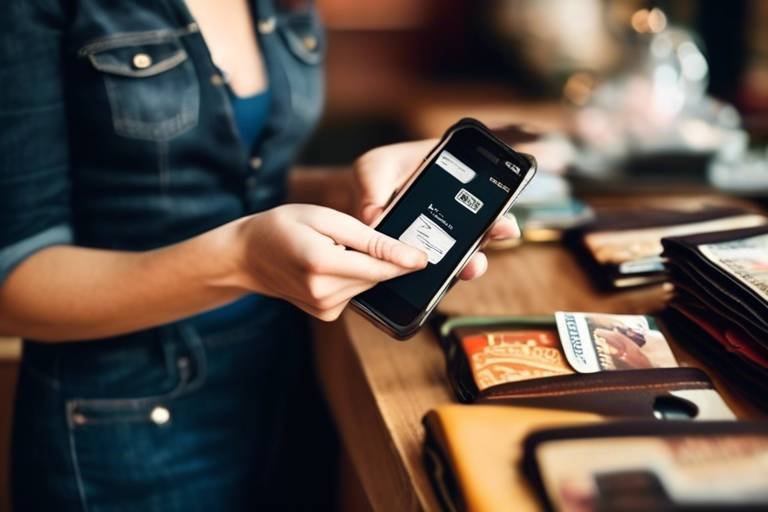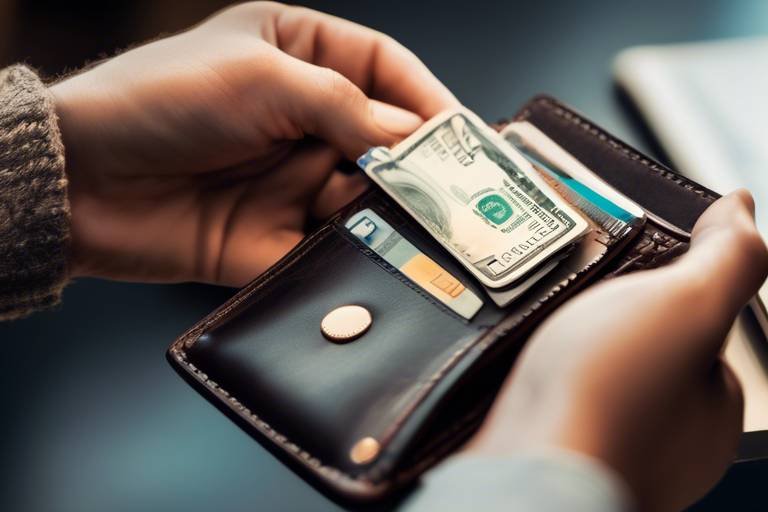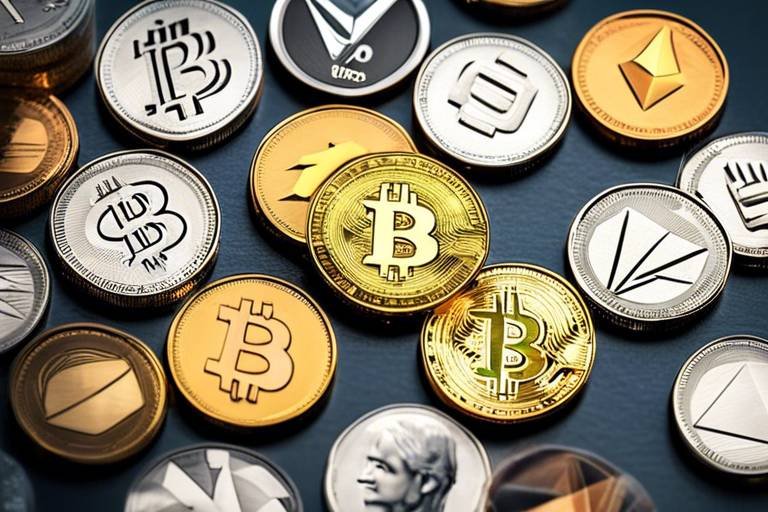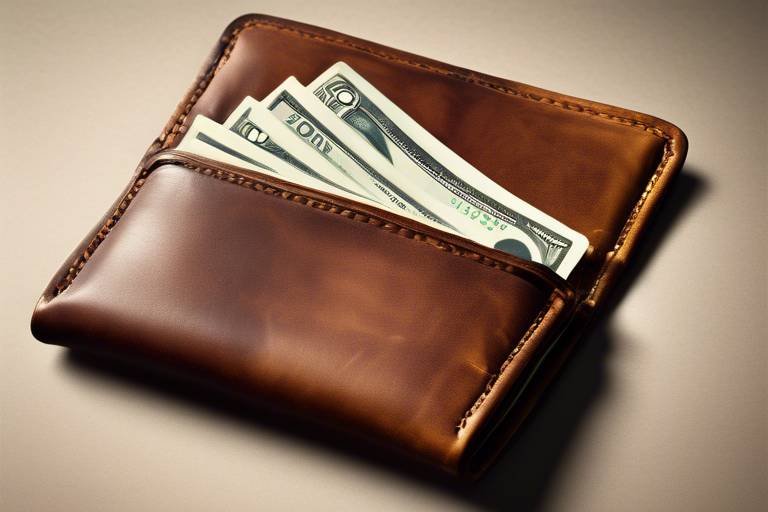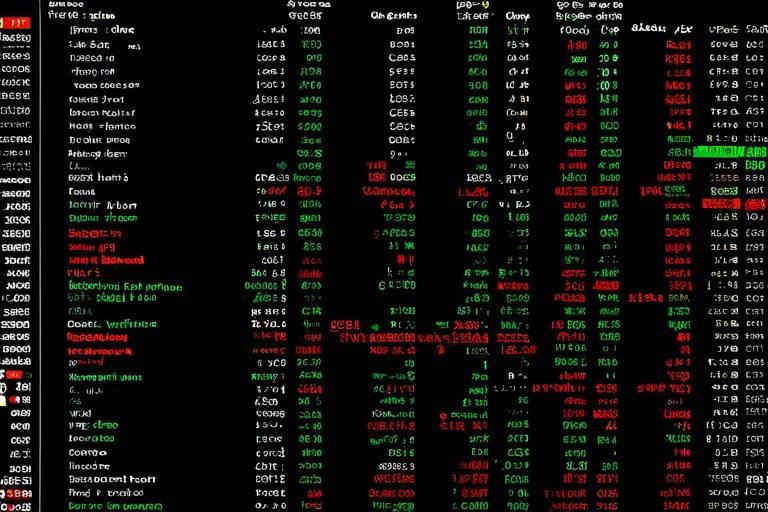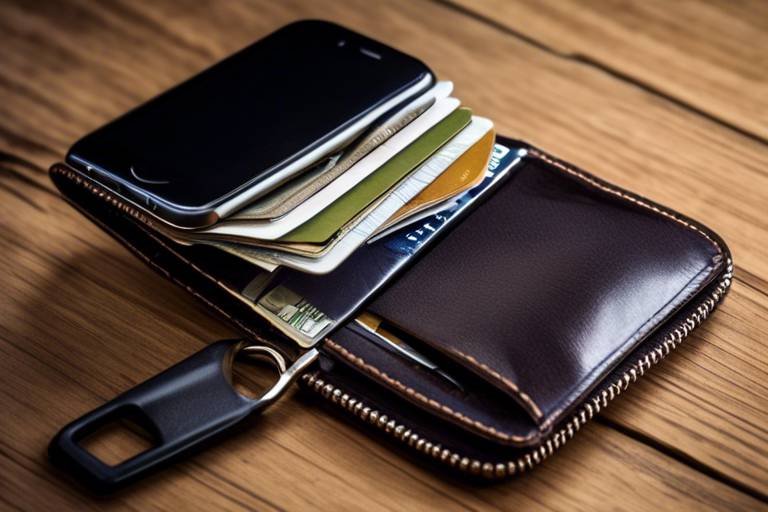How to Use Wallets for Health and Wellness Apps
In today’s fast-paced world, the intersection of technology and health is more relevant than ever. As we strive for better health and wellness, the tools we use to manage our fitness and well-being are evolving. One of the most significant advancements in this area is the integration of digital wallets with health and wellness applications. But what does this mean for you? Imagine effortlessly tracking your fitness goals while securely managing your payments for gym memberships, nutrition plans, or wellness products—all in one place. This article explores how digital wallets can transform your health and wellness journey, making it not only easier but also more secure and engaging.
Digital wallets are applications that allow users to store payment information securely. They act as a virtual wallet, enabling users to make transactions without the need for physical cards or cash. But how do they work? When you link your bank account or credit card to a digital wallet, the app encrypts your payment information, allowing you to make purchases quickly and safely. In the context of health and wellness apps, this functionality enhances your experience by streamlining payments and offering various features that cater specifically to your health needs.
Using wallets in health and wellness apps offers numerous advantages that can significantly enhance your experience. Here are some key benefits:
- Convenience: With a digital wallet, you can make payments in just a few taps, eliminating the hassle of entering your payment details each time.
- Security: Digital wallets utilize advanced security measures, ensuring that your sensitive health data and payment information are well-protected.
- Streamlined Transactions: Wallets can simplify the payment process, allowing for quicker checkouts and reducing the chances of abandoned transactions.
These benefits not only improve your user experience but also encourage more consistent engagement with health apps, which can lead to better health outcomes.
When it comes to handling health data and payments, security is paramount. Digital wallets provide advanced security measures to protect user information. For instance, they often employ two-factor authentication and data encryption, which are crucial in safeguarding your sensitive information.
Two-factor authentication (2FA) adds an extra layer of security to your digital wallet. But how does it work? Essentially, 2FA requires two forms of verification before granting access to your account. This could be a password combined with a unique code sent to your mobile device. By implementing 2FA, you significantly reduce the risk of unauthorized access, protecting your health-related transactions.
Data encryption is another vital feature of digital wallets. It ensures that your payment information is transformed into a code that can only be decrypted by authorized parties. This means that even if your data is intercepted, it remains unreadable to anyone without the proper keys. In health and wellness apps, this level of security is essential for protecting your personal data and maintaining your trust.
Convenience is a key factor in the adoption of digital wallets. They simplify the user experience in health and wellness applications by allowing for quick access to payment options and reducing the friction often associated with financial transactions. Imagine being at your favorite fitness class and needing to pay for a drop-in session. Instead of fumbling for cash or cards, you can simply tap your phone, and voila! You’re all set to work out. This seamless experience encourages users to engage more frequently with health apps, ultimately leading to better health outcomes.
For developers, integrating wallets with health apps can significantly enhance functionality. By implementing wallet features, developers can create a more cohesive user experience that meets the needs of health-conscious individuals. This integration could include:
Efficient payment processing is vital for user satisfaction. Wallets streamline payment transactions, making it easy for users to pay for subscriptions, classes, or health products without the hassle of traditional payment methods. This efficiency not only boosts user satisfaction but also encourages repeat usage of health apps.
Many health apps offer rewards for healthy behaviors, such as completing workouts or achieving fitness milestones. Wallets can facilitate the management and redemption of these rewards. Imagine earning points for every workout you complete, which you can then redeem for discounts on health products or services. This gamification of health encourages users to stay engaged and motivated, transforming their wellness journey into a rewarding experience.
Q: Are digital wallets safe to use with health apps?
A: Yes, digital wallets are generally safe to use. They employ advanced security features like encryption and two-factor authentication to protect your data.
Q: Can I use digital wallets for all health and wellness apps?
A: While many health and wellness apps are integrating wallet features, not all of them support digital payments yet. It’s best to check the specific app for compatibility.
Q: What should I do if I forget my digital wallet password?
A: Most digital wallets have a recovery process in place. You can usually reset your password through your email or mobile number linked to the account.

Understanding Digital Wallets
Digital wallets are revolutionizing the way we handle transactions, especially in the realm of health and wellness applications. Imagine having all your payment information securely stored in one place, accessible at the touch of a button! This convenience is one of the primary reasons why digital wallets have gained immense popularity. But what exactly are digital wallets, and how do they function?
At their core, digital wallets are applications that allow users to store various forms of payment information, including credit and debit card details, bank account numbers, and even cryptocurrency. They operate through a secure platform that encrypts your data, making it difficult for unauthorized users to gain access. This means that when you make a purchase or payment through a health app, your sensitive information is safeguarded, giving you peace of mind.
Digital wallets enhance transactions in health and wellness apps by streamlining the payment process. Instead of manually entering your card details every time you want to pay for a fitness class or a health supplement, you can simply select your wallet and authorize the transaction. This not only saves time but also reduces the risk of errors that can occur when inputting information repeatedly. In fact, many users report that the ease of use associated with digital wallets significantly improves their overall experience with health applications.
Additionally, digital wallets often come equipped with features that allow for seamless integration with other services. For instance, if you're using a wellness app that tracks your fitness goals, you might find that the app can automatically deduct payments for premium features directly from your wallet. This integration fosters a more cohesive user experience, making it easier to manage your health and wellness journey without the hassle of juggling multiple payment methods.
In summary, digital wallets are more than just a convenient payment option; they represent a shift towards a more integrated and secure way of managing transactions in health and wellness apps. By understanding how these wallets work and what they offer, users can take full advantage of their features, ultimately enhancing their health journey.

Benefits of Using Wallets
Using digital wallets in health and wellness apps is becoming increasingly popular, and for good reason! They offer a myriad of benefits that can significantly enhance your experience while managing your health. Imagine having all your payment information securely stored in one place, allowing you to focus on what truly matters: your well-being. The integration of wallets simplifies transactions and adds layers of security, making it a win-win for users.
One of the primary advantages is the **convenience** they provide. Picture this: you’re at a fitness center, and you want to sign up for a new class. Instead of fumbling through your wallet for cash or a credit card, you can simply use your digital wallet to make the payment instantly. This seamless experience not only saves time but also encourages users to engage more with health services. It’s like having a magic key that opens doors to various health opportunities without the hassle of traditional payment methods.
Moreover, digital wallets enhance **security**, which is crucial when handling sensitive health data and payment information. With advanced security features such as two-factor authentication and data encryption, users can rest easy knowing their information is well-protected. For instance, when you make a transaction through a wallet, your card details are not directly shared with the merchant, reducing the risk of fraud. This is particularly important in health and wellness applications, where personal data is often sensitive and confidential.
In addition to security, wallets also streamline the **transaction process**. Many health and wellness apps now allow users to link their wallets, enabling quick and easy payments for services such as telehealth consultations, gym memberships, or wellness products. This integration can significantly reduce transaction times, making it easier for users to access the services they need without unnecessary delays. Think of it as a well-oiled machine, where every part works together to ensure a smooth experience.
Furthermore, wallets can facilitate **rewards and incentives** programs. Many health apps offer points or discounts for engaging in healthy behaviors, such as completing workouts or attending wellness workshops. By integrating wallet features, users can easily track and redeem these rewards, enhancing their motivation to maintain a healthy lifestyle. Imagine earning points for every step you take, which can be redeemed for discounts on your favorite health products! This gamification of health can make the journey towards wellness not only rewarding but also fun.
In summary, the benefits of using wallets in health and wellness apps are vast and impactful. From convenience and security to streamlined transactions and rewards, wallets can significantly enhance user experience. As technology continues to evolve, the integration of digital wallets will likely become a standard feature in health applications, making it easier than ever for users to prioritize their health.

Enhanced Security Features
In today's digital landscape, where data breaches and cyber threats are rampant, security has become a top priority, especially in health and wellness applications. Users are increasingly aware of the sensitive nature of their health information and the financial details tied to their transactions. This is where digital wallets shine, offering a range of enhanced security features that help protect user data while providing a seamless experience. One of the most significant advantages of using digital wallets in health apps is the implementation of advanced security protocols designed to keep personal and financial information safe.
Among these features, two-factor authentication (2FA) stands out as a critical layer of security. By requiring users to provide two forms of identification before accessing their accounts, 2FA significantly reduces the risk of unauthorized access. Imagine this as having a double lock on your front door; even if someone has the key, they still need a combination to get in. This dual verification process typically involves something the user knows (like a password) and something they have (like a mobile device or an authentication app). This way, even if a hacker manages to steal a password, they would still be unable to access the account without the second factor.
Another essential security feature is data encryption. This technology transforms sensitive information into a coded format, making it unreadable to anyone who doesn’t have the decryption key. In the context of health and wellness apps, data encryption ensures that personal health records and payment details are safeguarded during transmission. For instance, when you make a payment through a health app, your credit card information is encrypted, ensuring that it cannot be intercepted and misused by malicious actors. Think of it as sending a secret message that only the intended recipient can decode. This level of protection is crucial for maintaining user trust and ensuring compliance with regulations like HIPAA (Health Insurance Portability and Accountability Act).
Furthermore, many digital wallets also incorporate biometric authentication features, such as fingerprint scanning or facial recognition. This is akin to having a personal bodyguard who verifies your identity before allowing access. By using unique biological traits, these methods provide an additional layer of security that is both convenient and difficult for hackers to replicate. When users can quickly and securely access their health apps, it not only enhances their experience but also encourages consistent engagement with the app's features.
To summarize, the enhanced security features of digital wallets play a pivotal role in ensuring that health and wellness applications can operate safely and efficiently. With two-factor authentication, data encryption, and biometric options, users can feel confident that their information is well-protected. As technology continues to evolve, we can expect these security measures to become even more sophisticated, providing users with peace of mind while they focus on their health and wellness journeys.

Two-Factor Authentication
When it comes to safeguarding sensitive health information, two-factor authentication (2FA) stands out as a robust security measure. Imagine you’re trying to enter a highly secure building; a simple key might not be enough. You’d need a second layer of verification, like a fingerprint or a code sent to your phone. That’s exactly what 2FA does for your digital wallet in health and wellness apps. It requires not just your password, but also a second piece of information to confirm your identity.
This method significantly reduces the risk of unauthorized access. For instance, even if someone manages to steal your password, they would still need that second factor—often a temporary code sent to your mobile device—to gain entry. This means your health data, payment details, and personal information are much harder for cybercriminals to compromise.
Here’s how two-factor authentication typically works in health and wellness apps:
- Step 1: You enter your username and password as usual.
- Step 2: A unique code is generated and sent to your registered mobile device via SMS or an authentication app.
- Step 3: You input this code into the app to gain access.
This simple yet effective process adds an extra layer of security, making it significantly more difficult for hackers to access your accounts. Moreover, many health and wellness apps offer users the option to enable 2FA during the setup process, making it easier than ever to protect your sensitive information right from the start.
In addition to enhancing security, 2FA can also foster trust between users and health app developers. When users know that their data is protected by stringent security measures, they are more likely to engage with the app and share their health information freely. This trust can lead to better health outcomes, as users feel more comfortable tracking their fitness goals, managing appointments, and making payments.
In summary, two-factor authentication is not just a technical feature; it’s a vital component of your overall health and wellness app experience. By implementing 2FA, you can rest easy knowing that your data is protected by more than just a password. It’s a simple step that can make a world of difference in the security of your health information.
- What is two-factor authentication?
Two-factor authentication is a security process that requires two different forms of identification to access an account, typically a password and a code sent to your mobile device. - Why should I enable two-factor authentication?
Enabling 2FA significantly enhances the security of your account by making it much harder for unauthorized users to gain access, even if they have your password. - How do I set up two-factor authentication?
Most health and wellness apps provide an option to enable 2FA in the security settings. Follow the prompts to link your mobile device for receiving codes.

Data Encryption
When it comes to safeguarding sensitive information in health and wellness apps, stands out as a vital pillar of security. Imagine sending a secret message to a friend; you wouldn’t want just anyone to read it, right? That’s exactly what encryption does—it transforms your data into a format that is unreadable to unauthorized users. In the context of health apps, where personal health records and payment information are often shared, encryption ensures that even if data is intercepted, it remains secure and confidential.
Encryption works by using algorithms to encode data. These algorithms scramble the information, making it nearly impossible for anyone without the correct decryption key to understand. For example, when you enter your payment details into a health app, that information is encrypted before it’s transmitted over the internet. This means that even if a hacker were to intercept the data, they would only see a jumble of characters instead of your actual credit card number.
Moreover, encryption is not just about protecting data in transit; it also secures data at rest. This means that even when your data is stored on servers, it remains encrypted, adding another layer of protection. In a world where data breaches are becoming increasingly common, the importance of encryption cannot be overstated. It provides a peace of mind for users, knowing that their sensitive health information is shielded from prying eyes.
Here are some key points about data encryption in health and wellness apps:
- End-to-End Encryption: This ensures that data is encrypted on the sender's device and only decrypted on the recipient's device, preventing unauthorized access during transmission.
- Compliance with Regulations: Many health apps must comply with regulations such as HIPAA, which mandates the protection of patient information through encryption.
- Regular Updates: Developers must regularly update encryption protocols to protect against new vulnerabilities and threats.
In summary, data encryption is a non-negotiable aspect of modern health and wellness applications. By converting sensitive information into a secure format, it not only protects users but also builds trust in the application. As users become more aware of the importance of data privacy, the demand for apps that prioritize encryption will only continue to grow.
- What is data encryption? Data encryption is the process of converting information into a coded format that can only be read by authorized users.
- Why is data encryption important in health apps? It protects sensitive health information from unauthorized access and ensures compliance with privacy regulations.
- How does encryption work? Encryption uses algorithms to scramble data, making it unreadable to anyone who does not have the decryption key.

Convenience and User Experience
In today's fast-paced world, convenience is everything. When it comes to health and wellness apps, users are always on the lookout for ways to simplify their routines and make their experiences as seamless as possible. This is where digital wallets come into play. By integrating wallets into health and wellness applications, developers can significantly enhance the user experience, making it not just easier but also more enjoyable. Imagine being able to track your fitness goals, schedule appointments, and manage payments all in one place—it's like having a personal assistant right in your pocket!
One of the most significant advantages of using digital wallets in these apps is the streamlined payment process. Users can quickly make transactions without having to enter their payment information repeatedly. This not only saves time but also reduces the frustration that often accompanies online payments. With just a few taps, you can pay for a gym membership, purchase supplements, or even book a yoga class. It’s as if you’ve got a magic wand that makes payments disappear!
Moreover, the integration of wallets allows for a more personalized user experience. Many health and wellness apps are designed to track user behavior and preferences. By connecting a digital wallet, these apps can offer tailored recommendations and promotions based on past purchases. For instance, if you frequently buy healthy snacks or fitness gear, the app might suggest similar products or even offer discounts. This level of personalization not only enhances user satisfaction but also encourages continued engagement with the app.
Another aspect to consider is the user interface. A well-designed wallet feature can significantly improve the overall look and feel of an app. Users appreciate intuitive designs that allow them to navigate effortlessly. Think of it like a well-organized kitchen: when everything is in its place, cooking becomes a joy rather than a chore. Similarly, a clean and efficient wallet integration can turn the often tedious task of managing payments into a breeze.
Finally, let’s not overlook the importance of customer support. Users love knowing that help is just a click away. When wallets are integrated into health and wellness apps, it’s crucial for developers to provide robust support options. Whether it’s through live chat, FAQs, or tutorials, having accessible assistance can make all the difference. After all, when users feel supported, they are more likely to stick around and continue using the app.
In summary, the incorporation of digital wallets into health and wellness applications not only enhances convenience but also elevates the overall user experience. From streamlined payments to personalized recommendations and excellent support, wallets are transforming how we engage with these essential tools for our health. So, if you haven’t yet explored the world of digital wallets in your favorite health apps, now is the time to dive in and discover the ease and efficiency they bring!

Integrating Wallets with Health Apps
Integrating digital wallets into health and wellness applications is more than just a trend; it's a transformative step towards enhancing user engagement and satisfaction. Imagine having all your health-related transactions seamlessly managed in one place, where you can pay for gym memberships, purchase supplements, or even book wellness services without the hassle of entering your payment details repeatedly. This integration not only simplifies the payment process but also fosters a more cohesive user experience.
Developers looking to incorporate wallet features into their health apps should focus on a few key areas to ensure optimal functionality. For instance, the payment processing aspect is crucial. By utilizing wallets, health apps can facilitate quick and secure transactions, allowing users to complete purchases with just a few taps. This efficiency is particularly important in today’s fast-paced world, where users seek instant gratification. With wallets, payments can be processed in real-time, reducing the friction often associated with traditional payment methods.
Moreover, wallets can significantly enhance user engagement through rewards and incentives. Many health and wellness apps today encourage users to adopt healthier lifestyles by offering rewards for achieving fitness goals or maintaining healthy habits. By integrating wallet functionality, users can easily manage and redeem these rewards. For example, a user could earn points for attending yoga classes, which they can later redeem for discounts on future classes or health products. This gamification of health not only motivates users but also creates a more interactive experience.
To illustrate the potential benefits of integrating wallets with health apps, consider the following table that summarizes key features and their advantages:
| Feature | Advantages |
|---|---|
| Quick Payment Processing | Reduces transaction time, enhancing user satisfaction. |
| Reward Management | Encourages user engagement through gamification. |
| Transaction History | Provides users with insights into their spending habits. |
| Seamless Integration | Offers a unified experience across different health services. |
In conclusion, the integration of wallets with health and wellness apps is a win-win for both developers and users. It simplifies transactions, enhances engagement through rewards, and ultimately leads to a more satisfying experience. As technology continues to evolve, the potential for wallets in the health sector will only expand, paving the way for innovative solutions that prioritize user convenience and security.
Q1: What are digital wallets?
A1: Digital wallets are applications that allow users to store payment information securely and facilitate easy transactions online and in-store.
Q2: How do wallets enhance security in health apps?
A2: Wallets employ advanced security features such as encryption and two-factor authentication to protect sensitive health data and payment information.
Q3: Can I use my wallet for all health and wellness transactions?
A3: While many health apps support wallet integration, it ultimately depends on the individual app's features and partnerships with payment providers.
Q4: Are there any fees associated with using digital wallets?
A4: Some wallets may charge transaction fees, but many health apps absorb these costs to provide a seamless experience for users.

Payment Processing
In the world of health and wellness apps, efficient payment processing is not just a luxury; it's a necessity. Imagine you're in the middle of a workout session, feeling pumped and motivated, and suddenly, you need to purchase a new fitness program or a healthy meal plan. The last thing you want is a complicated payment process that disrupts your flow. This is where digital wallets come into play, transforming the payment landscape into something seamless and user-friendly.
Digital wallets simplify the payment process by allowing users to store multiple payment methods in one secure location. This means that whether you prefer using a credit card, debit card, or even cryptocurrency, you can easily select your preferred method without fumbling through your wallet or purse. With just a few taps on your smartphone, you can complete your transaction and get back to focusing on your health goals.
Moreover, the integration of wallets with health apps enhances the overall user experience. Users can link their wallets directly to their accounts, allowing for quick checkouts and automatic payment options. This not only saves time but also reduces the chances of cart abandonment, a common issue in online transactions. In fact, studies have shown that apps with integrated wallets see a significant increase in conversion rates compared to those without.
Here are some key aspects of how payment processing through digital wallets works:
- Instant Transactions: With digital wallets, payments are processed instantly, meaning you won't have to wait for your purchase to go through. This immediacy is crucial, especially when you're eager to access a new feature or service.
- Recurring Payments: Many health apps offer subscription services for premium content. Digital wallets can manage these recurring payments effortlessly, ensuring that users never miss out on their favorite features.
- Transaction History: Users can easily track their spending and see a history of their transactions. This transparency helps in budgeting and managing health-related expenses.
Furthermore, the ability to use digital wallets for payments in health and wellness apps opens up opportunities for personalized user experiences. For instance, if you frequently purchase workout plans or nutritional guides, the app can analyze your spending habits and offer tailored recommendations. This not only enhances user satisfaction but also fosters loyalty to the app, as users feel that their preferences are being recognized and catered to.
In conclusion, the integration of payment processing through digital wallets in health and wellness apps is a game-changer. It streamlines transactions, enhances user experience, and ultimately contributes to a healthier lifestyle by removing barriers to access. So next time you're considering a new app, look for those that offer digital wallet integration—your workouts (and your wallet) will thank you!
Q: What is a digital wallet?
A: A digital wallet is an application that allows you to store payment information securely and make transactions online or in-store using your smartphone.
Q: How does using a digital wallet enhance security?
A: Digital wallets use advanced security measures such as encryption and two-factor authentication to protect your payment information and personal data.
Q: Can I use a digital wallet for subscription payments?
A: Yes, many health and wellness apps allow you to set up recurring payments through digital wallets, making it easy to manage your subscriptions.
Q: Are there any fees associated with using digital wallets?
A: While most digital wallets are free to use, some may charge fees for certain transactions or services. It's always best to check the terms and conditions of the wallet you choose.

Rewards and Incentives
In today's fast-paced world, maintaining a healthy lifestyle can sometimes feel like an uphill battle. However, many health and wellness apps are stepping in to make this journey not only easier but also more rewarding. By integrating digital wallets into these applications, users can seamlessly manage their rewards and incentives, turning healthy choices into tangible benefits. Imagine earning points for every workout you complete or receiving discounts for reaching your dietary goals! That's the magic of combining digital wallets with health apps.
One of the most exciting aspects of these integrations is the ability to track and redeem rewards effortlessly. Users can accumulate points or credits for various activities, such as completing fitness challenges, attending wellness workshops, or even logging their meals. With a digital wallet, these rewards can be stored and accessed in one place, making it incredibly convenient to keep up with your achievements. For instance, after hitting a milestone, you might receive a notification that you have enough points to redeem a discount on your next gym membership or a free health consultation.
Moreover, the gamification of health and wellness is a significant trend, and digital wallets play a crucial role in this. By offering rewards, apps can encourage users to engage more consistently. This could be in the form of:
- Cashback Offers: Users can receive a percentage of their spending back when they make purchases related to health and wellness.
- Exclusive Discounts: Users can unlock special deals on health products or services after reaching specific goals.
- Gift Cards: Accumulated points can be exchanged for gift cards to popular fitness stores or health food shops.
It's not just about the rewards themselves; it's about creating a community of motivated individuals. When users see their progress and the rewards they can earn, it fosters a sense of accomplishment and encourages them to stick with their health goals. Additionally, many apps now feature leaderboards or social sharing options, allowing users to compare their achievements with friends or family. This social aspect can be incredibly motivating and can lead to friendly competition, further enhancing user engagement.
To sum it up, integrating digital wallets with health and wellness apps transforms the way users interact with their health journeys. It creates a cycle of motivation, engagement, and reward that can lead to lasting lifestyle changes. So, the next time you log into your favorite health app, take a moment to explore the rewards waiting for you. You might just find that your healthy choices are more rewarding than you ever imagined!
- What are digital wallets? Digital wallets are applications that securely store payment information and allow users to make transactions easily.
- How do rewards work in health and wellness apps? Users earn points or credits for completing health-related activities, which can be redeemed for discounts or products.
- Are digital wallets safe to use? Yes, most digital wallets utilize advanced security measures such as encryption and two-factor authentication to protect user data.
- Can I use my digital wallet for multiple health apps? Absolutely! Many digital wallets can be linked to various apps, allowing for seamless transactions across platforms.
Frequently Asked Questions
- What is a digital wallet?
A digital wallet is an application that securely stores your payment information and allows you to make transactions online or in-person without the need to carry physical cash or cards. It's like having a virtual purse or wallet that keeps all your payment methods in one place!
- How do digital wallets enhance health and wellness apps?
Digital wallets improve health and wellness apps by making transactions easier and more secure. They allow users to pay for services or products quickly, manage subscriptions, and even track rewards—all from their smartphones. This convenience can lead to a better overall user experience!
- Are digital wallets safe to use for health-related transactions?
Yes! Digital wallets come with advanced security features like data encryption and two-factor authentication, which help protect your personal information and financial data. Think of it as having a high-tech lock on your digital wallet that only you can open!
- What is two-factor authentication?
Two-factor authentication (2FA) is a security process that requires two forms of verification before granting access to your account. For example, after entering your password, you might receive a code on your phone that you need to enter. This adds an extra layer of protection, making it harder for unauthorized users to access your information.
- How does data encryption work in digital wallets?
Data encryption is a method of converting your information into a code to prevent unauthorized access. When you use a digital wallet, your payment details are encrypted so that even if someone intercepts the data, they won't be able to read it. It's like sending a secret message that only the intended recipient can decode!
- Can I earn rewards using digital wallets in health apps?
Absolutely! Many health and wellness apps offer rewards programs for healthy behaviors, and digital wallets can help you manage and redeem these rewards easily. It’s a fun way to stay motivated while also enjoying some perks for your healthy choices!
- What should I do if I forget my digital wallet password?
If you forget your digital wallet password, don't panic! Most wallets have a recovery option that allows you to reset your password through your email or phone number. Just follow the prompts, and you’ll be back in your wallet in no time!
- Are digital wallets compatible with all health and wellness apps?
While many health and wellness apps support digital wallets, not all of them do. It's best to check the app’s payment options or settings to see if it integrates with your preferred digital wallet. If it doesn't, you might want to suggest it to the developers!



